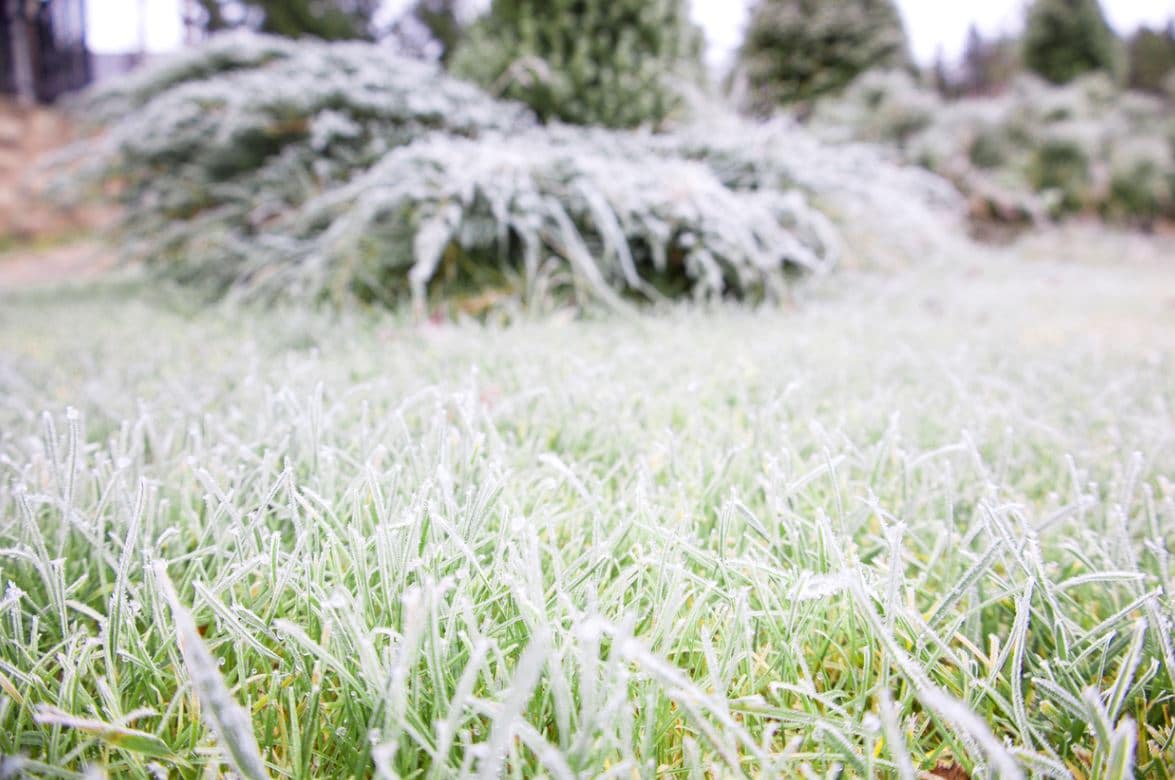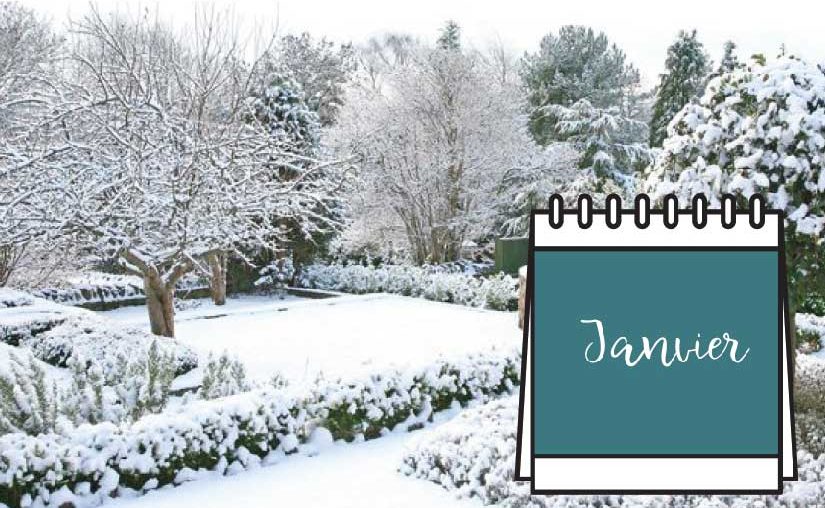Does your garden seem a little sad at the moment? Think there isn’t much to do there? Think again ! Even these harsh times are brightened up by plants, and much work awaits you.
Gardening: summary of what to do in January
- Make sure the birds have enough to eat and drink.
- Watch for and eliminate winter germinating weeds.
- Remove soggy leaves from wreaths.
- Continue digging as long as the soil conditions allow. Cover the ground to protect it from moisture.
- Order summer flowering seeds and bulbs.
- Inspect newly planted trees and shrubs. Replace them if they have been lifted by the frost.
- Shake the snow off overloaded trees, shrubs and hedges, before its weight breaks the branches.
- Check the stakes of trees and shrubs.
- Protect plants sensitive to wind and cold.
- Plant the deciduous shrub hedges.
- Practice pruning trees and shrubs.
- Prune wisteria and other vigorous climbers.
- Take woody cuttings from trees and shrubs.
- Take root cuttings from perennials.
- Follow the growth of the forced bulbs.
- Sow sweet peas under cover.
- Aerate the lawn to improve drainage.
- Make sure that the pool is not frozen over its entire surface.
- Sow early vegetables under cover.
- Pre-sprout early potatoes.
- Protect fruit trees from birds.
- Plant the fruit trees and practice winter pruning.
- Force rhubarb.
- Sow summer transplanting plants under cover.
Last deadline:
- Prune the vine before the sap starts to rise.
- Protect the plants in the container from freezing and isolate the outside taps.
Prepare for the future:
- Warm up plots of land under a hood, in preparation for the first sowing in the ground.
- Clean pots and boxes for spring sowing.
- Send the mower for service.
The gardener’s weather forecast for January
The winter temperatures in France depend a lot on the oceanic influence and the disposition of the relief. January and February often experience great cold attacks. At night, temperatures can drop sharply if the skies are clear, the wind is not blowing, and the land is covered with snow. The coldest air is at ground level. Mouthe (Doubs) holds the record for cold, which is -35 ° c on January 3, 1971. Average temperatures are 0-3 ° c in the east, 3-7 ° c in the west and 9 ° c. in Corsica.
January is often swept by strong winds or even violent storms, accompanying the depressions that cross France from west to east. The number of windy days and their strength therefore vary depending on the region, with an average of 11 windy days in Marignane and 12 days in Brest for 2.5 days in Bourg-Saint-Maurice or Vichy.
The Mediterranean region enjoys excellent sunshine, while some Breton islands benefit from a microclimate allowing them to see fig trees and mimosas growing. In the South, the sun shines at its peak in January for 155 hours in Perpignan for just say, 60 hours in Pans.
The amount of rain falling on France also depends on the topography (mountain or plain) and the proximity of the Atlantic, the South and the East being the driest regions. It generally falls 33 mm of rain in Strasbourg, 47 in Marseille to 101 mm in Bordeaux or 138 in Brest.
It rarely snows in coastal areas compared to the mountainous massifs which are often well endowed. It may very well not snow at all during the winter in some areas when others will experience heavy downpours on a regular basis. We note 1 3 days of snow on average in the Alps and barely 1 in Nice.
A chilly wind, frost and heavy rains
These climatic conditions often give the impression that nothing can be done in the garden at this time. But even if January is one of the coldest months of the year, we can also say that it carries all the hopes, and rave about these few plants that dare to flower.
Without being distracted by explosions of contrasting colors, it’s time to admire the elegant silhouettes of the bare branches, the color and texture of the bark, the solid and reassuring habit of the evergreens. And a garden bursting with snow under the wintry sun is always a sight full of grace.
Watch the weather
A blanket of snow can be beneficial for the garden, as it destroys unwanted pests and protects plants from severe frosts. However, keep a close eye on the weather forecast, especially warnings of heavy snowfall or frost, as measures will need to be taken to protect certain plants.
Conifers are particularly sensitive to snowfall, as the weight of the snow can break branches or cause them to bend badly.
Fruit cages can also suffer a lot under the weight of heavy snow.
Strong winds are also one of the characteristic features of January: it is therefore essential to check the staking of young trees and shrubs, especially in regions exposed to storms; just as essential is providing a wind barrier to newly planted shrubs. The bite of the wind can be devastating, especially on evergreen leaves.
Young leaves are at risk of burning, and in these cases they rarely recover. During the winter, temporary protection will ensure the investment you have made in new plants.
Sometimes the frost is more intense in certain areas of your garden, especially if it has a slope or drop. Since cold air is heavier than hot air, it accumulates in the lower parts. This fact must absolutely be taken into account when choosing the location of the frost plants. This warning also applies to fruit trees planted below in a pocket of frost: this can be very dangerous for flowers in spring.

A little exercise
The days are getting longer imperceptibly, take the opportunity to restore your health after the Christmas holidays.
If you want to warm up on a cold winter day, go back to digging flower beds and vegetable gardens, provided the soil is neither saturated with water nor frozen. If the ground is frozen, now is the time to apply manure or garden compost.
Lawns will also benefit from your care, even if it is still only the middle of winter. In a few months, a soft green lawn will generously reward all the work done now.
But avoid trampling the grass when it is frozen. Now is also the time for repairs: take a tour of the garden and inspect the fences and trellises. All cleaning operations will change the face of the garden on sunny days. Always have a small notebook in your pocket when doing crafts in the garden.
It will be useful for you to write down all the ideas for modifications that you want to make in the garden, and especially the plants to buy later.
To the pleasure of the eyes
Less tiring, a walk around the garden in January can hold many surprises, for example the snowdrops and the yellow carpet of the blooming winter aconite. Another January must-have is the Christmas rose, Helleborus niger, which despite its name blooms in January, but the dazzling white of its flowers is well worth the wait. Protect the plants when the buds start to open, you will prevent the rain or snow from staining the flowers.
In winter, do not forget either the immense ornamental contribution of the shrubs with decorative bark. Dogwoods (Cornus), for example, if they were pruned in the spring, offer the eye bright winter stems in all shades of red, green, yellow and even black.
Evergreen shrubs and conifers of all hues, from dark green to gold, also add a touch of life and sparkle to winter decor.
The fragrance is another added value of many plants in this season: chimonanthe, Viburnum x bodnantense and sarcococca which welcome the new year with surprising fragrances.
Planning for the future
If the weather is too cold and humid to venture outside, there is plenty to take care of inside.
Now is the perfect time to plan all the jobs for the year. An essential task is to make yourself comfortable and browse the seed catalogs while enjoying a hot drink.
You can also go to the nearest garden center and buy your seeds. And even if the first spring bulbs are not yet ready to hatch, it is already time to choose those that are summer flowering.
The first sowing
It’s not too early to start sowing the early crops, the ones that always give the most pleasure and, of course, will save you the most money.
Summer bedding plants that are particularly slow growing, such as pelargoniums and snapdragons (Antirrhinum), can also be started towards the end of the month. If you have a greenhouse or winter garden that is heated enough to prevent freezing, you’re good to go, but a greenhouse is not essential for many plants that can be grown on garden edges. window.
Growing your own plants from seedlings is always exciting, even for a seasoned gardener. It’s very simple, but a few accessories are needed to add extra warmth this season.
Heating an entire greenhouse is very expensive these days, and many plants can start in a mini propagating greenhouse. Plants like tomatoes and frost-prone summer transplants require this little extra heat to germinate, preferably from the soil.
This is where a multiplication greenhouse, where the compost heats gently from the base, comes in handy. There are many models. Your choice will depend on the cost, the space available and the quantity of seeds to be sown. The cheapest and simplest greenhouses do an excellent service.
Pay close attention to electrical appliances, especially those in contact with moisture, and follow the manufacturer’s instructions to the letter. If in any doubt, check with the manufacturer or a professional electrician.
A little DIY
A useful piece of equipment on the shelves in the greenhouse, and invaluable if you only have the kitchen table to prepare your seedlings, is the potting box, with a back and sides that avoid spilling compost all over the place. .
There you go, this month is going to be almost as active as a summer month. You are surely impatient to get started.
Read also :
- What to do in the garden in February: maintenance, pruning, planting
- What to do in the garden in March: maintenance, pruning, planting
- What to do in the garden in April: maintenance, pruning, planting
- What to do in the garden in May: maintenance, pruning, planting
- What to do in the garden in June: maintenance, pruning, planting
- What to do in the garden in July: maintenance, pruning, planting
- What to do in the garden in August: maintenance, pruning, planting
- What to do in the garden in September: maintenance, pruning, planting







